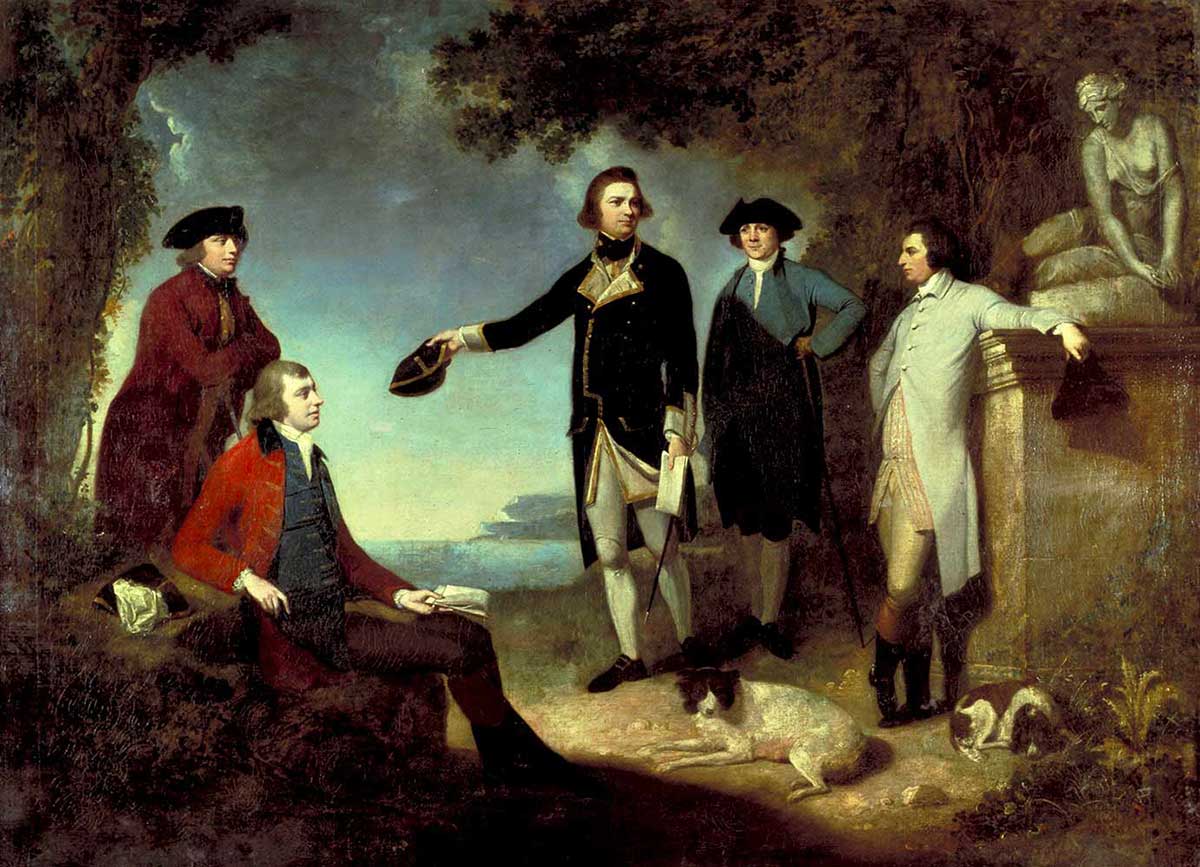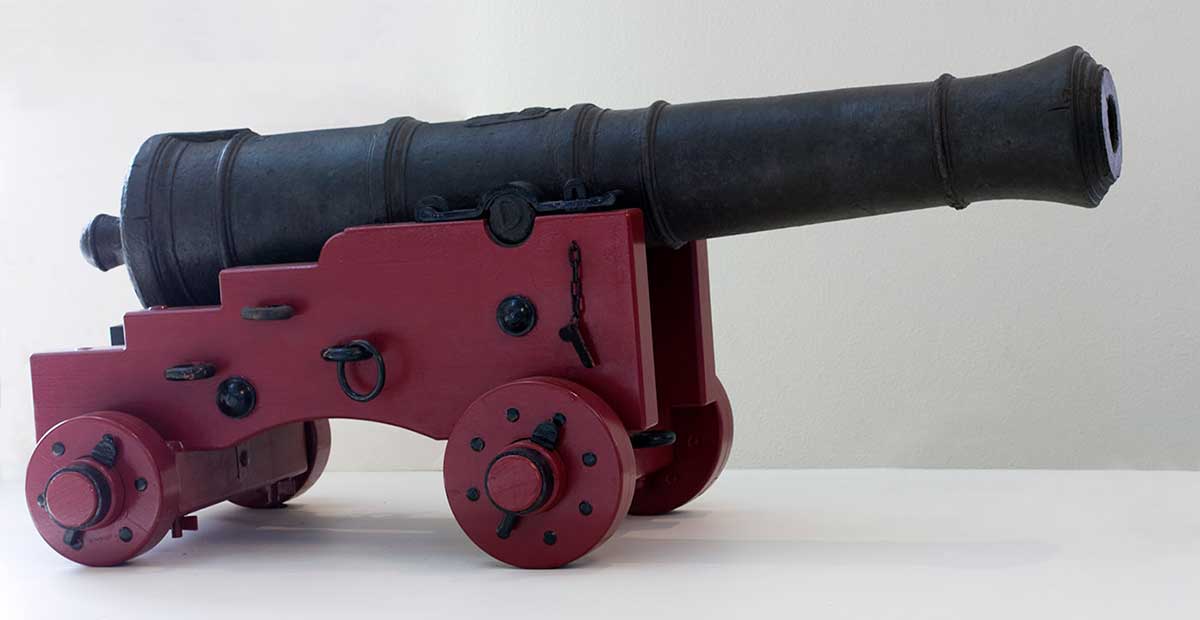DEFINING MOMENTSCook claims Australia
1770: Lieutenant James Cook claims east coast of Australia for Britain
Lieutenant James Cook, captain of HMB Endeavour, claimed the eastern portion of the Australian continent for the British Crown in 1770, naming it New South Wales.
In his journal, he wrote: ‘so far as we know [it] doth not produce any one thing that can become an Article in trade to invite Europeans to fix a settlement upon it’.
Eighteen years later, the First Fleet arrived to establish a penal colony in New South Wales.
Lieutenant James Cook’s journal, 22 August 1770:
Notwithstand[ing] I had in the Name of his Majesty taken posession of several places upon this coast I now once more hoisted English Coulers and in the Name of His Majesty King George the Third took posession of the whole Eastern Coast from … Latitude [38° South] down to this place by the Name of New South Wales together with all the Bays, Harbours Rivers and Islands situate upon the said coast after which we fired three Volleys of small Arms which were Answerd by the like number from the Ship.Cook’s ‘Chart of part of the South Sea, Shewing the Tracts and Discoveries made by His Majesty’s Ships, 1773’. National Library of Australia, MAP NK 11035.Voyage of HMB Endeavour
The 1768–71 voyage of HMB Endeavour – Lieutenant Cook’s first major command – was motivated by the desire to claim the honour of first discovery.
The Royal Society of London, which had instigated the voyage, wished to take part in international scientific efforts to the discover the ‘Astronomical Unit’ – the distance from the Earth to the Sun – by sending Cook and an astronomer to Tahiti to observe the transit of Venus across the face of the Sun.
King George III had given the voyage his blessing and made available the resources of the Royal Navy in hopes of both scientific and strategic advances. He and the British government were eager to discover and annex the Great South Land long believed to lie in the uncharted waters of the Pacific.
Joseph Banks Esq, the Royal Society’s representative aboard Endeavour, had financed the considerable costs of his party of nine civilians and their extensive scientific equipment in the pursuit of undiscovered plants, animals and human societies.
Considerable international prestige would attach to those whose observations helped fix the Astronomical Unit.
French marble portrait bust of Captain Jacques Cook
Choosing a route home
Cook carried out his observation of the Transit of Venus on 3 June 1769, and left six weeks later having spent three months in Tahiti.
For the Admiralty, the Transit of Venus observation provided a useful pretext for sending a British ship into the Pacific so it could look for the Great South Land, which they thought existed somewhere to the east of Australia. It was also an opportunity to map the Pacific, which was largely uncharted.
From Tahiti, Cook sailed to Huahine, Bora Bora and Raiatea before heading south-west in search of the Great South Land.
Not finding it, he sailed to New Zealand and spent six months charting its coast. (Cook exploded the myth of a habitable Great South Land in on his second voyage (1772–75).
It was the possibility of adding further discoveries to the already impressive list of the expedition’s achievements that underlay his decision to choose a route home via New Holland’s east coast.
A return to England via Cape Horn (the southern tip of South America) would have allowed Cook to continue his search for the Great South Land, but his ship was unlikely to weather the Antarctic winter storms this route entailed.
The more direct but already well-travelled path south of Van Diemen’s Land to the Cape of Good Hope (the southern tip of Africa) would be quicker, but offered nothing new.
The limits of the east coast of New Holland however, were unknown, and Cook was eager to determine whether the strait shown on many maps separating the continent from New Guinea actually existed.
Banksia serrata from Banks’s Florilegium
Sailing Australia’s east coast
HMB Endeavour spent a little over four months sailing and mapping the coast between Point Hicks – that portion of the east coast in present-day Victoria first spotted by Second Lieutenant Hicks on 19 April 1770 – and Possession Island in the Torres Strait.
Determined to beat the monsoon winds and with stores running low, Cook stopped only briefly along the way to replenish the ship’s supplies of wood, water and, where possible, food.
Cook spent only eight days at Botany Bay despite the remonstrations of Banks and Daniel Solander, both eager to collect natural history specimens.
That would have been the expedition’s longest pause on the coast had the Endeavour not stuck fast on a coral outcrop of the Great Barrier Reef at high tide late in the evening of 10 June off what is now Cooktown in far north Queensland.
‘The ship struck and stuck fast’
The journals of those on board record the nightmarish 24 hours that followed as the sails were got down and six cannon, thousands of gallons of water and tons of ballast were jettisoned to lighten the ship.
Everyone took their turn working the three functioning pumps to clear the water flowing in through the gash in the ship’s hull.
Too far from the coast to swim to safety and with too few boats to carry all on board, the expeditioners faced death if the ship broke up.
At high tide the next evening the ship was winched off the coral using lengths of rope attached to the anchors that had been rowed out and positioned in readiness.
The Endeavour slowly made for shore, a fothering sail pulled over the damaged portion of the hull reducing the inflow of water. The ship’s small bower anchor could not be retrieved, and was left behind.
Endeavour River
On the morning of 17 June the ship entered the mouth of the Endeavour River, safe from the gales that arrived the next day.
With no knowledge of whose country they were on or what resources they might find, the crew began work on emptying the ship and repairing the damage to her hull. Marvelling at their good fortune, they found a large piece of coral still jammed in the hull, which had slowed the inrush of water.
Nearly seven weeks later, the Endeavour was ready to sail again; the health of the crew had been restored, valuable food supplies secured and extensive collections of natural history specimens gathered, including the improbable kangaroo.
And, unlike the clear rejection of their overtures by the Gweagal people of Botany Bay, the ship’s company established good relations with the Guugu Yimithirr people, although Cook’s refusal to share with his hosts any of the turtles his men had captured was considered an abuse of hospitality and caused serious offence.
Navigating the Great Barrier Reef
After several false starts, HMB Endeavour re-entered the waters of the Great Barrier Reef on 4 August and spent 18 dangerous days and nights at the mercy of sudden wind shifts and strong tides as her captain picked a path through the shoals, sandbanks and coral reefs.
On 17 August, having battled for hours to prevent the ship being dashed onto a reef, Cook expressed a little of the strain he was under, writing: ’Was it not for the pleasure which naturly [sic] results to a Man from being the first discoverer, even was it nothing more than sands and Shoals, this service would be insuportable [sic].′
Defining Moments: Cook’s exploration of Australia’s east coast5:41TV presenter Mikey Robins and senior curator Michelle Hetherington discuss a cannon jettisoned by Cook when the Endeavour struck a reef off northern Queensland.
Claiming New South Wales for the Crown
Five days later, finally clear of the labyrinth of reefs and having proved the existence of the Torres Strait, Cook climbed the summit of Possession Island and claimed the east coast of the Australian continent for Britain.
The trials of the voyage were not over yet. One-third of those who had faced death on the reef would die of fever and dysentery contracted at Batavia (present-day Jakarta) before the Endeavour reached England again.
In his detailed account of his journey along the coast, Cook stated that ‘… the Country it self so far as we know doth not produce any one thing that can become an Article in trade to invite Europeans to fix a settlement upon it …’
Despite this damning assessment, Cook’s claim would lead to the establishment of a British penal colony in New South Wales 18 years later.
29
Cook had intereactions with 2 Indigenous Groups but proclaimed New South Wales for the British.
So why didnt the British Admiralty followup regarding Indigenous as is their Duty.
Why didnt the British send the First Fleet till 18 years later to create a Penal Colony?
- Forums
- Political Debate
- Cook claims Australia
Cook claims Australia
- There are more pages in this discussion • 283 more messages in this thread...
You’re viewing a single post only. To view the entire thread just sign in or Join Now (FREE)




































![Map showing the estuary of the Endeavour River. It’s title is A plan of the entrance of Endeavour River, New south Wales. Latitude 15’ 26” South. References. A. Where we landed our stores. B Repaired the Ship. C A small bank of Sand where we caught many fish with the [seine net].](https://www.nma.gov.au/__data/assets/image/0006/548430/add_ms_7085_42-434-h-x-335-w_o2-1200h.jpg)









